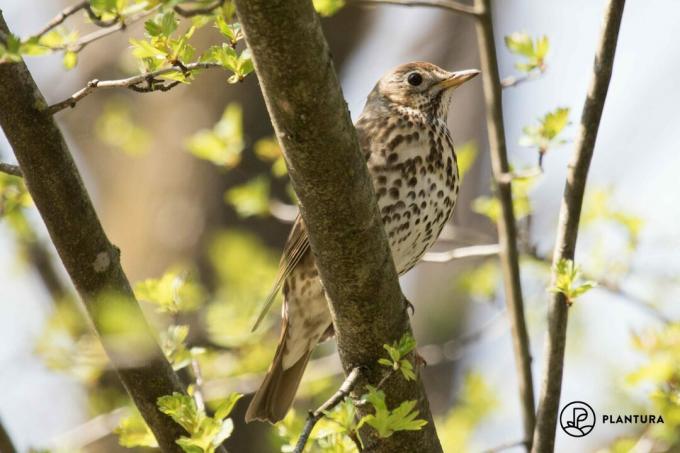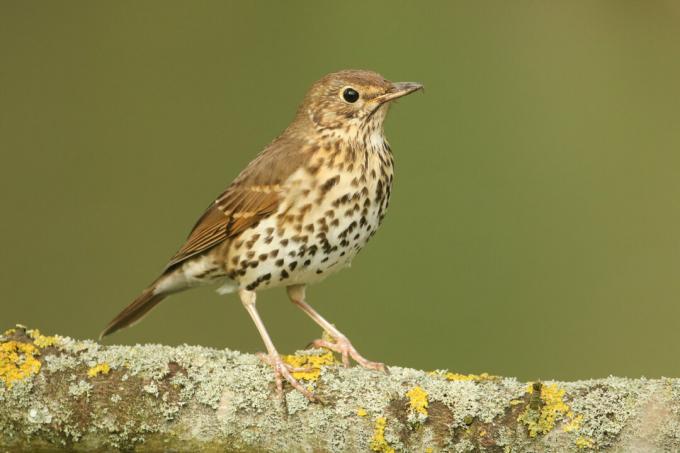How do you recognize a song thrush by its appearance and song? When does the song thrush breed and what do their young birds look like? And where is the song thrush's habitat? We will answer these and other questions for you here.

The song thrush (Turdus philomelos), also called Zippe or summer thrush, is a close relative of the blackbird and resembles this in shape and size. At first glance, the untrained eye could even mistake the song thrush for a young blackbird. This is patterned a little lighter than its parents and thus even resembles the song thrush in terms of color. At second glance, however, the song thrush is a lot lighter and more conspicuously patterned. It takes its name from its melodic, imaginative and diverse singing, which can still be heard in local parks and gardens in the evenings. When and where the song thrush breeds, how to support it in your own garden and everything What else you need to know about the songbird can be found here in our large species portrait.
contents
- Song thrush: fact sheet
-
This is how you recognize the song thrush
- What does the song thrush sound like?
- What does the typical song thrush egg look like?
- In which habitat can the song thrush be found?
- Where does the song thrush build its nest?
- What time does it breed?
- Where does the song thrush spend the winter?
-
Support the song thrush in the garden: This is how it works
- What do song thrushes eat?
- Are nesting boxes suitable for song thrushes?
- Tips for additional support
Song thrush: fact sheet
| size | About 20 - 22 cm |
| weight | About 60 - 70 g |
| Breeding season | March - August |
| lifespan | Up to 10 years |
| habitat | Forests, parks and gardens |
| Feed preference | Worms, snails, insects, berries and fruits |
| Threats | Decline in food and living space |
This is how you recognize the song thrush
The song thrush is a bit smaller and slimmer than the well-known blackbird. At first glance, it resembles the female and young blackbirds and divides their brown-gray plumage on their backs and wing covers. In contrast, her belly is colored white and the song thrush's chest shines in a warm shade of yellow. Black, arrowhead-shaped spots also form a high-contrast pattern on the light background. These spots are a good distinguishing feature, which differentiates the song thrush from other thrush species. The very similarly colored mistletoe, for example, has round spots and can therefore be clearly distinguished.

A visual distinction between male and female song thrushes is unfortunately not possible. And the young birds also look very similar to their parents as soon as they have reached their full size.
What does the song thrush sound like?
The song of the song thrush consists of varied, polysyllabic motifs, which are typically repeated two to four times. It's quite melodic, but not as full-sounding and throaty as the blackbird's song.
You can listen to the song thrush singing in this sound recording:
The call of the song thrush, on the other hand, consists of a sharp "zip", which changes into a sharp "tix-tix-tix-tix-tix" when excited, which is similar to the blackbird's warning call.

What does the typical song thrush egg look like?
Female song thrushes lay between four and six bright blue-green eggs, which are about 2.7 centimeters in size and covered with black spots of varying degrees of intensity.

In which habitat can the song thrush be found?
The summer thrush prefers forests rich in undergrowth with adjacent open land areas that are used as feeding grounds. But it can also feel at home in urban parks, cemeteries or near-natural gardens, as long as there is enough protective undergrowth.
Where does the song thrush build its nest?
The zipp builds its nest in the dense vegetation of trees, hedges or bushes. But also man-made structures such as wall niches or building projections are used by the free breeders as nesting places. The nest itself is made from small branches, moss and other plant parts and lined with a mixture of wood fibers and saliva, which form a solid shell after drying.

What time does it breed?
The song thrush breeding season extends from March to August. During this time, a breeding pair can successfully raise up to three broods. The incubation period per clutch is between 12 and 14 days. The young birds are born naked and blind and are given food by their parents in the nest for another two weeks before they make their first attempts at flight and leave the nest.
Where does the song thrush spend the winter?
Song thrushes are Migratory birds, which overwinter mainly in the south or south-west of Europe. In mild winters, however, you can occasionally observe zippings in Central Europe as they search for food in the barren landscape. As with other bird species, attempts to overwinter in breeding areas could become more frequent with increasing climate change.
Support the song thrush in the garden: This is how it works
Due to the increasing monotonization and intensification of our landscape, more and more wild birds can be found in settlement areas and cities, where they seek refuge in parks and gardens. Find out here how you can design your garden in a bird-friendly manner and offer the song thrush an inviting home.
What do song thrushes eat?
Most of the time, song thrushes feed on animal foods such as worms, snails, and insects. Zipping is also a clever way to get to the meaty interior of the snail shell appropriated: You knock the snails on a stone until the shell breaks and the little animals exposed. In the late year, however, they also use berries and fruits.

Song thrushes are not particularly interested in seeds and grains, which is why they cannot be lured with classic birdseed. However, you can still support the songbirds - for example with berry-bearing, bird-friendly plants or one insect friendly garden.
Are nesting boxes suitable for song thrushes?
Since song thrushes are free breeders and prefer to hide their nests in trees and other vegetation, closed nesting boxes are not suitable for them. These only come to cave breeders, like Coal Tit, Redstart or Glue, benefit. Song thrushes, on the other hand, can be better supported with natural nesting sites such as hedges, bushes or trees. These should grow as densely as possible and only be thinned out little or not at all, so that the thrushes can hide their nests well in them.
Tips for additional support
In addition to plenty of food, birds naturally also need water. However, in hot summers, built-up areas such as settlements and cities can often experience shortages due to a lack of water sources such as puddles, ponds or streams. With the attachment of a Bird bath in the garden you can therefore provide excellent support for the song thrush and a multitude of other garden birds. What to do when installing and cleaning a Bird bath should be observed, you can find out in our information article.
Another species of bird, which also belongs to the thrush and is happy about a rich garden and a bird bath, is the Fieldfare. Get to know this native wild bird a little better in our species portrait.
